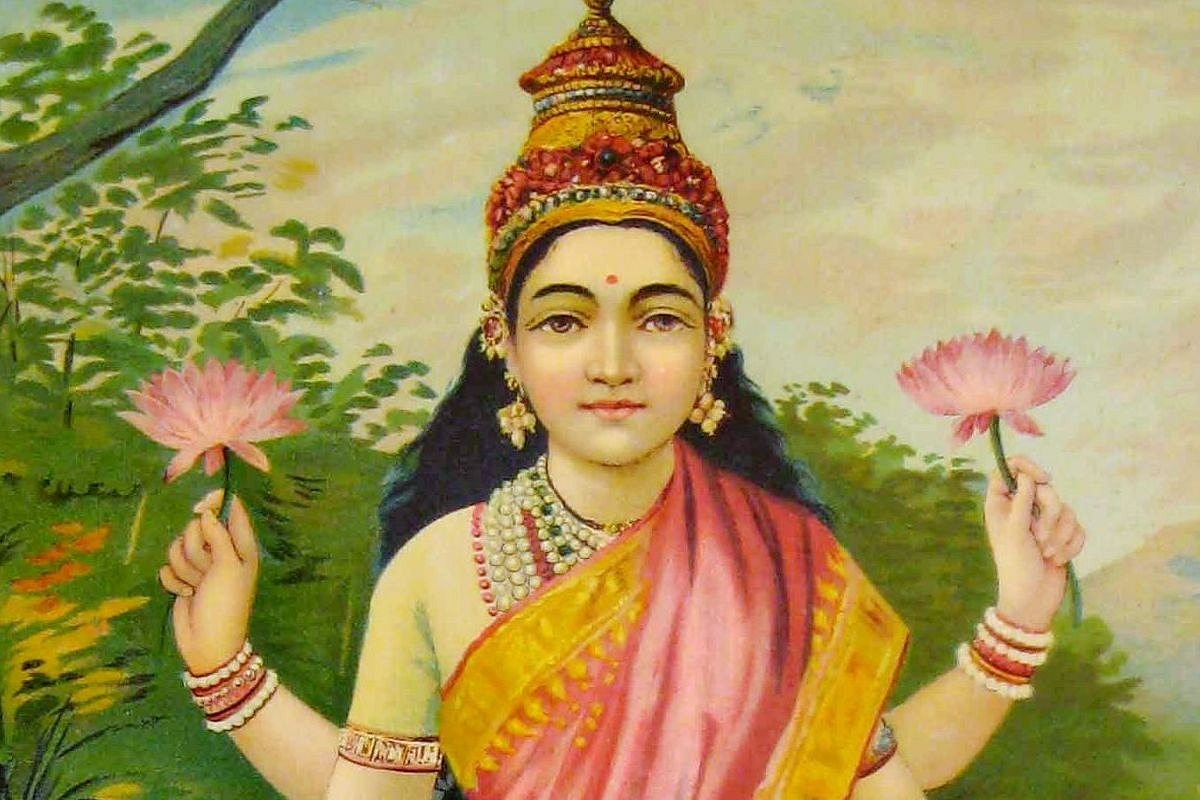Ideas
Random Meditations Through Her 1000 Names (XIV): The Gems In Her Crown
- She fulfils the 'purusharthas' of those who meditate on her form as the queen of universes, wearing a crown in which kuruvinda gems are embedded in rows.

Lakshmi by Raja Ravi Varma (Wikimedia Commons)
Read part thirteen here.
Kuruvinda manisreni kanatkotiramandita - She whose feminine crown is magnificently dazzling with rows of kuruvinda gems.
The very second name in the Sri Lalita Sahasranama says that she is a queen in her own right.
She is Maharajni.
So, as she emerges from the chit-agni-kunda, or the inner fire-pit of consciousness, her crown becomes visible.
Hindu culture differentiates between the crown of the king and that of the queen.
The male head has not much to show. Hence, the entire head gets covered by the crown.
But the female hair locks are by themselves beautiful. They are further beautified by the way the hair locks are tied in different styles and also by the flowers which further increase their aesthetics. All these cannot be hidden.
So, in the Hindu tradition, the crown worn by the queen, and in this case the queen of all the universes, inner and outer, the parallel universes and the multiverses, does not hide the splendour of her hair and the beauty of the flowers she wears. This special crown is called kotiram.
It is interesting to note here that in both the Christian and Islamic traditions, women are forbidden from showing their hair. Women of piety are expected to cover their hair.
Even though Mary provides the human womb for the son of the male deity, her hair would be covered even after her ascension and even after she gets crowned.
This underlines the difference between the sacred feminine in Hindu dharma and the Christian religion.
In the latter, the highest point the feminine reaches is as the interlocutor between the highest divine and the faithful.
In the former, the highest conception of divine is inseparable from the feminine and in Shaktic traditions, the divine is entirely and essentially feminine. So the feminine form does not have to show her piety by covering her head and show submission.
Just as how by the term 'Maharajni' she shows her independent, royal nature, even her crown shows her supremacy as the divine feminine.
Hindu sculptors throughout the ages took the challenge of depicting the intricate design of her crown, that attained its beauty by adoring her head, without hiding the graceful charm of her splendid hair.
And what does that crown have?
It is studded with a gem, kuruvinda.
The choice of the gem here is important.
Her crown shines with rows of kuruvinda gems. The kuruvinda gem is used to check the veracity of a diamond. According to Hindu tradition on gems, a kuruvinda that is reddish has an 'inner lustre ...such as even that surpasses the brightest of gems.'
According to Mani-Mala, a traditional Hindu treatise on gems, kuruvinda is the gem for Kshatriyas and padmaraga is for the Vipra. Thus, the presence of kuruvinda in her crown re-emphasises her role as the Maharajni of all the universes.
In the Hindu tradition, every gem is associated with specific characteristics. According to traditional commentary on Sri Lalita Sahasranama, the kuruvinda gem is associated with kama (urge for pleasure), anuraga (love) , mangalam (prosperity) and Vishnu bhakti (devotion to Vishnu).
It is interesting to note that each of these correspond to one of the four purusharthas: mangalam or prosperity is artha, and anuraga, or love, is the Dharma that channelises both the acquiring of artha and the fulfilment of kama in a way that is not injurious to rta - the cosmic harmony. And Vishnu bhakti is the way to liberation or moksha.
So, what is implied in the name is that by meditating on the most beautiful form of the goddess, with the crown in which kuruvinda gems are embedded in rows, the goddess fulfils the purusharthas.
Thus, through this name, the goddess is meditated upon as both the ruler of all the universes and the purushartha-fulfilling, nourishing mother for every being that meditates on her as emerging from the inner fire-pit of Consciousness.
Support Swarajya's 50 Ground Reports Project & Sponsor A Story
Every general election Swarajya does a 50 ground reports project.
Aimed only at serious readers and those who appreciate the nuances of political undercurrents, the project provides a sense of India's electoral landscape. As you know, these reports are produced after considerable investment of travel, time and effort on the ground.
This time too we've kicked off the project in style and have covered over 30 constituencies already. If you're someone who appreciates such work and have enjoyed our coverage please consider sponsoring a ground report for just Rs 2999 to Rs 19,999 - it goes a long way in helping us produce more quality reportage.
You can also back this project by becoming a subscriber for as little as Rs 999 - so do click on this links and choose a plan that suits you and back us.
Click below to contribute.
Latest